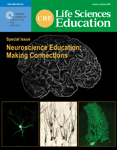WWW: Neuroscience Web Sites
The human brain contains an estimated 100 billion neurons, and browsing the Web, one might be led to believe that there's a Web site for every one of those cells. It's no surprise that there are lots of Web sites concerning the nervous system. After all, the human brain is toward the top of nearly everyone's list of favorite organs and of intrinsic interest to scientists and nonscientists alike. In this review I will focus primarily on three excellent Web sites that represent three very different approaches to Web design and educational media. At the end of this review, I list a number of noteworthy neuroscience Web sites but without extensive remarks.
THE ILLUSION OF SCIENCE
To begin, as a reminder of the wonder of the human nervous system, let's consider some optical illusions. A commercial site, Sandlot Science (http://www.sandlotscience.com/; Figure 1), has one of the best collections of optical illusions on the Web. The illusions are optimized for viewing on the Web and include interactive Flash-based features, as opposed to simply presenting flat-art illustrations on a Web page. I recommend taking one of their tours. Sandlot even provides an estimate of how many minutes each exploration will take. One of the most perplexing illusions is called the “Mysterious Mind Tap,” number 4 on Tour 1. I look forward to seeing readers' explanations of how this amazing trick works. Like most optical illusion Web sites, including those posted by academics, Sandlot is frustratingly short on rigorous explanations of how the illusions trick our visual systems. In part this is a good lesson on how far we have to go in understanding even such a well-studied nervous component as the visual system.
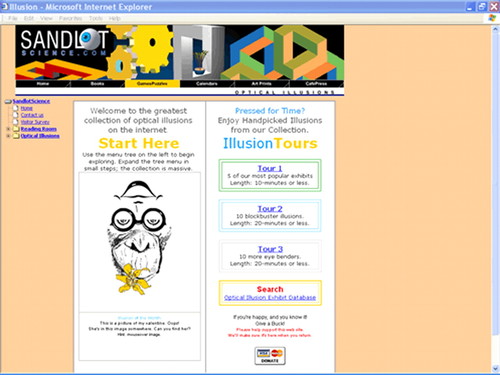
Figure 1. Sandlot Science.
Another commercial Web site, Grand Illusions (http://www.grand-illusions.com/), sells some interesting toys and has first-rate illusions freely available on the Web site. They also have some nice video demonstrations and explanations. Two of my favorites are the Dragon Illusion and Dr. Angry and Mr. Calm. The Dragon Illusion (http://www.grand-illusions.com/opticalillusions/dragon_illusion/) is illustrated with a very effective online video. In case you are wary of camera tricks, you can also print out the illusion, paste it together, and check it out for yourself; it really works. I have made dragons of different sizes, and the illusion is scalable. I'd like to see a huge version in a town square or a mall. Dr. Angry and Mr. Calm (http://www.grand-illusions.com/opticalillusions/angry_and_calm/; Figure 2) is a very effective illusion that works well online and might also work in a classroom as long as students are free to move about the room. Are my eyes deceived, or should this illusion be renamed Dr. Angry and Ms. Calm?

Figure 2. Dr. Angry and Mr. Calm.
Hopefully, playing with optical illusions will get students thinking about how the visual system and other brain centers process information. Students might even be wondering whether it's the eyes or higher brain centers that are being tricked. The University of Wisconsin has a Web site (http://www.physiology.wisc.edu/yin/public/) that contains amazing videos of original Hubel and Wiesel experiments on cat receptive fields. Seeing how receptive fields work can lead one to think about how such mechanisms could be fooled by various visual features in the environment.
Before we leave sensory systems, I'd like to recommend at least one comprehensive site on the visual system, put together by three faculty members at the University of Utah John Moran Eye Center. WEBVISION (http://webvision.med.utah.edu/) is not particularly interactive, but it is very well organized and features some beautiful illustrations and photographs. Keeping in mind that we have other sensory systems, have a look at Dangerous Decibels (http://www.dangerousdecibels.org/virtualexhibit.cfm#) built in partnership by Oregon Museum of Science and Industry and Oregon Health and Science University. The site aims to encourage young people in particular to take care of their hearing, and it includes some interesting simulations of what things sound like under various conditions of hearing impairment. It had me thinking twice about the volume on my iPod.
THE BRAIN FROM TOP TO BOTTOM
The great challenge, and advantage, in teaching about the nervous system is the huge diversity of topics and levels of analysis in neuroscience. Neuroscience researchers are supreme reductionists, down to their favorite molecules. Neuroscientists are also interested in emergent properties of mind and even social systems. Their toolkit ranges from DNA sequencer to computer-assisted analysis of behavior. Perhaps no Web site more overtly embraces the full range of neuroscience analysis than The Brain From Top to Bottom (http://www.thebrain.mcgill.ca/flash/index_d.html; Figure 3). In fact the very design of the Web site attempts to epitomize the various levels of neuroscience analysis.
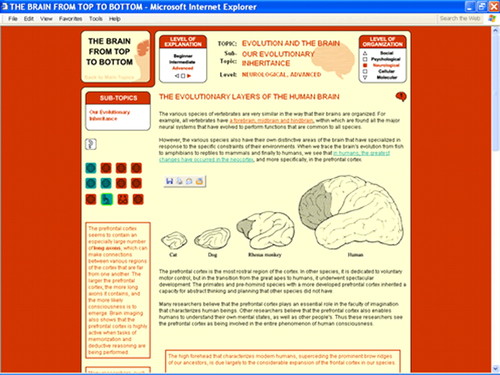
Figure 3. The Brain from Top to Bottom.
The Brain From Top to Bottom was developed, researched, written, and “copylefted” by Bruno Dubuc and hosted by McGill University (sponsored by the Canadian Institutes for Health Research and the Canadian Institute of Neurosciences, Mental Health, and Addiction). Copyleft means that the content is free for reuse and even modification; however, other than some quirky creativity, the site is focused not on the politics of intellectual property, but on neuroscience. This handsome, well-designed site is worth looking at first and foremost for its ambitious attempt to promulgate a design that organizes material by topic: Functional Anatomy, Memory, Pleasure and Pain, Emotions, Brain Evolution, Movement, The Senses, and Mental Disorders (Development, Language, Sleep and Dreams, and Consciousness are “under development”). Via parallel threads by level of biological organization, the site offers Social, Psychological, Neurological, Cellular, and Molecular content. Third, the material is presented according to color-coded options of Beginner (orange), Intermediate (teal), and Advanced (red) levels of explanation. As if that weren't enough, the Web site is available in French and English. Viva la synapse!
How does this complicated-sounding scheme work? For example, under the topic of “Memory”—advanced explanation—social level, we find a discussion of Dawkins' memes concept and the transmission of culture. Shifting to beginner explanation, oral tradition and writing are discussed. Moving to the psychological level—beginner explanation, short- and long-term memory are covered, and more detailed flow-charts of memory are presented along with more technical descriptions at the advanced level. At the molecular level, long-term potentiation is covered for beginners and glutamate and synapses are mentioned. Intermediate explanation adds information on receptor subtypes, and advanced explanation gives details of second-messenger cascades and gene activation.
The core Web site content is bolstered by five categories of Supplementary Information: Experiment, History, Linked, Tool, and Research. I found the supplemental categories a bit confusing because the Experiment category did not necessarily describe specific experiments, and the Tool modules didn't discuss methods or techniques. That said, the short Tool module, for example, on the relationship between ontogeny and phylogeny and the “recapitulation” argument is one of the better short explanations of Haeckel's natural law. The site also features provocatively titled Guided Tours: “Why do I say so many stupid things when I get drunk?” “Why do I make myself sick, instead of just strangling my boss?” “Why can I remember exactly what I was doing the morning of September 11, 2001?” “What's the connection between the Big Bang and a brilliant chess move?” These questions will draw you and your students in for self-guided learning.
The emphasis of the Web site is good design, clear graphics, and engaging explanation. Because of this emphasis, I think this site is particularly worthy of study by faculty and other independent, small-scale, developers of learning media. From a technology and resources viewpoint, anyone could make a site like this. All the energy and resources have gone into the design, functionality, esthetic, and content. Given the interesting design of this Web site, I look forward to continued addition of neuroscience topics and subtopics and perhaps the incorporation of some interactive media.
SUMANAS
The previous Web site illustrated the power and elegance that a Web site can have without any multimedia content. The Sumanas Web site (http://www.sumanasinc.com/index.html; Figure 4) is elegant and completely driven by multimedia animation, mostly implemented using Shockwave. Sumanas is a commercial provider of multimedia services, and they have made much of their product available for free on their Web site (smart marketing in my opinion). At www.sumanasinc.com/webcontent/anisamples/neurobiology/neurobiology.html they have assembled nine animated tutorials on neurobiology, most developed to supplement the 2004 textbook Biological Psychology by Rosenzwieg et al. (Sinauer).

Figure 4. Sumanas Web site.
These animations are well-drawn, moving illustrations emphasizing concepts, rather than photorealistic three-dimensional (3D) animations. Because the animations are fairly lengthy, running two to five minutes, the Shockwave downloads take one to two minutes, even on my fast Enterprise LAN connection. All the animations, covering Synaptic Transmission, Electrical Signaling in Neurons, AMPA and NMDA Receptors, Sound Transduction, Visual Pathways, Receptive Fields, Reflex Arcs, Receptors in the Skin, and PET, have a nice clean look. The accompanying narration sounds a bit stilted and crowded, almost like a wordy textbook figure legend. However, the narration can be turned off, and a step-through mode with explanatory text can be used instead, but I confess that I found it easier to follow the animations with the narration on.
The animation titled Sound Transduction (Figure 5) provides a good example of their animation style. The animation begins at the gross anatomical level and shows the viewer how sound waves progress through the outer, middle, and inner ear. At appropriate places, anatomical views are expanded to show physiological details. Once in the inner ear, the view is expanded to explain in detail the function of the cochlea's basilar membrane. Viewers will see a simulation of the basilar membrane when stimulated by various sound frequencies. It is interesting to compare this very effective 2D style of animation to a similar 3D animation, called The Cochlea (Figure 5, right) on HHMI's BioInteractive Web site (http://www.hhmi.org/biointeractive/neuroscience/animations.html). The 3D animation is perhaps more engaging in some ways, as is seeing the basilar membrane respond to music as opposed to pure tones. Nevertheless, the Sunamas animation is very easy to follow and goes on to explain the response of hair cells associated with the basilar membrane. Both styles of animation can play a role in illustrating difficult concepts.
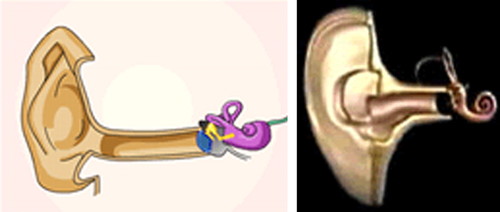
Figure 5. “Sound Transduction” from Sumanas Web site (left) and “The Cochlea” from HHMI's BioInteractive Web site (right).
Each Sunamas animation includes introductory and concluding text and a short interactive quiz. With only nine animations, the site cannot be comprehensive, but the topics are well chosen, covering molecular, cellular, and anatomical levels. While you're on the Sunamas Web site, you might also like to have a look at other animations that they've produced on topics such as stem cells and malaria (http://www.sumanasinc.com/scienceinfocus/scienceinfocus.html).
TUTIS VILIS
The level of Shockwave animation featured on the Sunamas Web site is probably beyond the skill level and time available for most faculty to achieve. However, Tutis Vilis in the Department of Physiology and Pharmacology at the University of Western Ontario has developed two Flash-based Web courses that show the sort of excellence that an individual faculty-developer can achieve in multimedia Web design (http://www.med.uwo.ca/neuroscience/vilis/courses.htm).
The Physiology of the Senses (http://www.med.uwo.ca/physiology/courses/sensesweb/) is a Web-based course for undergraduates that is used by students in more than 60 countries. The site is well thought-out and organized, with the end-user student in mind. It starts off by helping you check for proper Flash plug-in functionality. The primary learning modules are designed in Flash, but instructions and many materials are also provided in PDF format. Each of the 12 topics (including The Eye, Visual Cortex, Visual Perception, Association Cortex, Touch, Muscle Sense, Balance, and Memory) includes an animated Flash session, a PDF with excellent illustrations and explanations, a set of interactive “practice” problems, and a set of links related to the particular topic. All of the course information is organized in an easy-to-view grid, with each feature opening in its own window. Therefore, the entire course and user instructions can be organized in outline manner on a single homepage for the course.
Dr. Vilis' other Web-based course is a neurophysiology course designed for first-year medical students (http://www.med.uwo.ca/physiology/courses/medsweb/). It is really a nine-part overview of the brain, emphasizing functional anatomy, but also including some cellular and molecular information. I really liked Lesson 5, Vestibular System and Eye Movements (Figure 6).
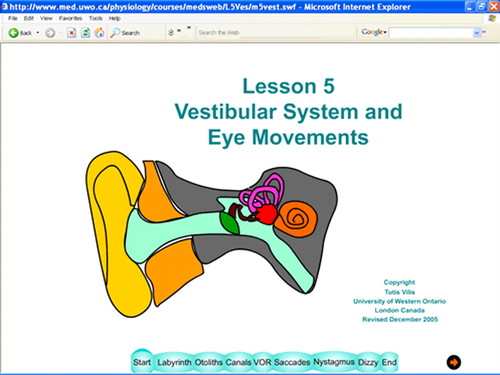
Figure 6. Vestibular System and Eye Movements.
The lesson begins with a schematic of the ear and related organs. A sort of blue gut tube at the bottom of the page shows you where you are in the lesson and also doubles as navigation if you want to skip ahead or go back. The first several sections of the lesson cover gross anatomy and general functions of hearing and balance. Next, some details of how kinocilium function is presented and is nicely related to movements of the head. The semicircular canals get a similar treatment, and then the lesson moves on to the vestibulo-ocular reflex. A very effective animation shows how each eye's movements need to be linked to the other, as well as to movement of the head, in order to maintain a stable visual image on the retina. In a series of very nice steps, the entire circuit is laid out in cellular detail, always related to animated movements of the head and eyes. The feature ends with engaging visual explanations of nystagmus and dizziness.
In addition to excellent animation, the site makes good use of the vector-based graphics of Flash, meaning that the images and text scale to whatever size you make your browser window, a blessing to those of us with creeping presbyopia, a topic that I hope Dr. Vilis will add to his course soon.
OTHER NEUROSCIENCE WEB SITES IN BRIEF
The Mind Project (http://www.mind.ilstu.edu/curriculum/) focuses on the development of curriculum modules for teaching the cognitive sciences. The Project is looking for instructors to author and pilot modules.
Focus on Neuroanatomy
http://www.med.harvard.edu/AANLIB/home.html: The Harvard Brain Atlas is a repository of human brain images. Interactive tools allow you to advance serially through brain sections in various planes, viewing images produced by various imaging technologies.
http://www.brain-map.org/welcome.do: The Allen Brain Atlas is primarily a database of gene expression in the human brain. The rapidly expanding database has good images and search functions.
http://www.brainmuseum.org/: The Brain Museum is an extensive online photo collection of mammalian brains, including information on development and function.
http://synapses.mcg.edu/: Synapse Web has excellent images and tutorials focusing on synaptic structure.
http://isc.temple.edu/neuroanatomy/lab/: The Neuroanatomy Lab is a good comprehensive neuroanatomy Web site with lots of images and interactive quizzes, emphasizing clinical aspects.
Focus on Neurology
http://www.advancesinneurology.com/: Advances in Neurology focuses on epilepsy, Parkinson's disease, and Alzheimer's disease. The many videos are aimed primarily at physicians and patients.
http://www.dana.org/brainweb/: The Dana Foundation's Brainweb focuses on mental health, including brain injury, aging, sleep, addiction, and inherited diseases.
http://thalamus.wustl.edu/course/: Washington University School of Medicine Neuroscience Tutorial presents the basics of clinical neuroscience emphasizing neuroanatomy.
http://www.sci.uidaho.edu/med532/: The University of Idaho's Nervous System Course is a very nicely laid out introduction to medical neuroscience.
Focus on Kids
http://faculty.washington.edu/chudler/neurok.html: Eric Chudler's Neuroscience for Kids has been a favorite of teachers since the mid-1990s. The site includes neuroscience in the news, hands-on student activities, and online interactive games.
http://www.brainsrule.com/: Brainsrule is designed to appeal to kids with interactive games and lots of cartoon graphics and includes teacher curriculum pages.


